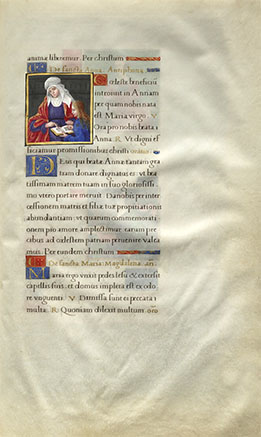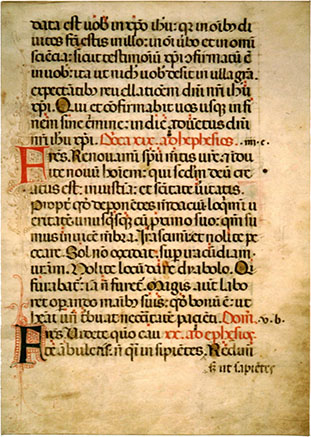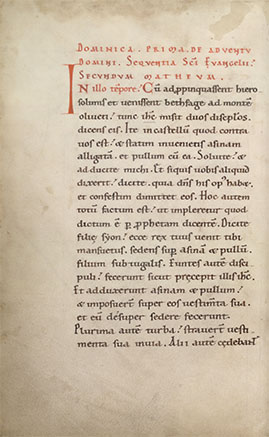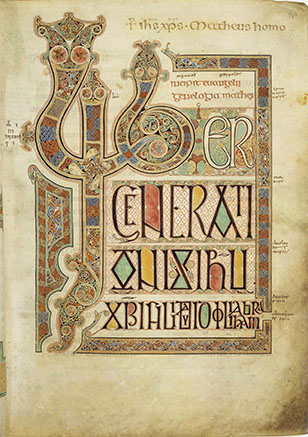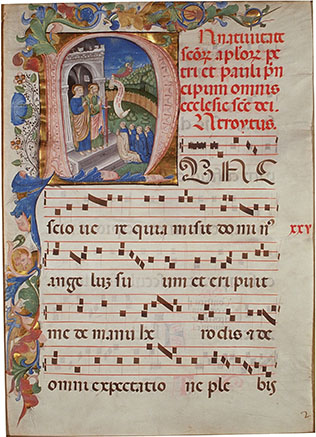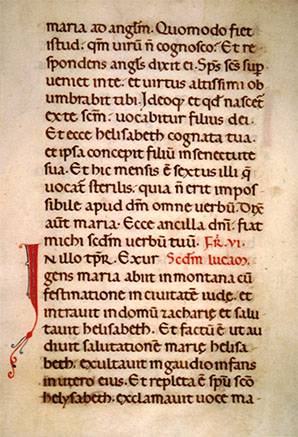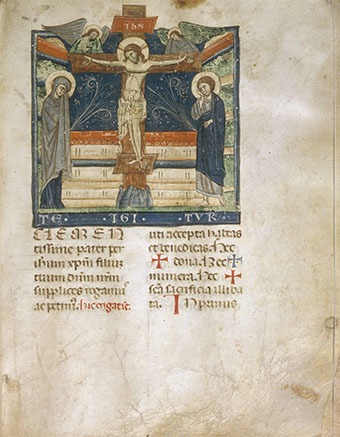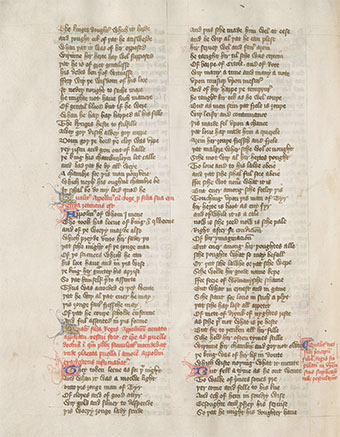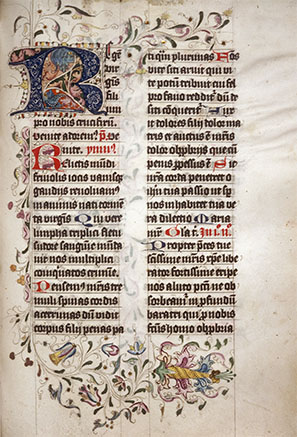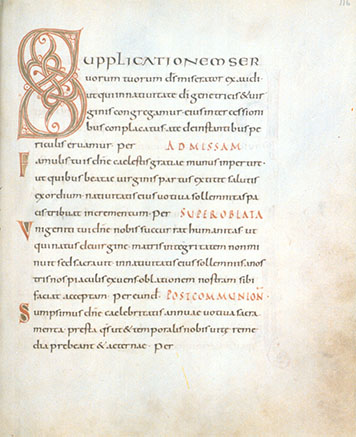55
Liturgical Service Books: A Field Guide
Between the fall of the Roman Empire and the invention of movable type, and with the notable exceptions of Charlemagne’s court or the Parisian university scribes of the 13th century, virtually all scribes were associated with monasteries, and virtually all book were religious – either Bibles, or more commonly, liturgical service books.
The service books began as simply excerpts of the Bible for use during the mass. Over time, as the mass became increasingly complex, more specialized books were created to serve specific functions for the priest, deacon or choir. Many of these early texts ended up as part of more comprehensive books, such as the breviary or the missal.1
This list presents only the most commonly encountered examples and completely skips the Bible, which is a subject to itself.
Antiphonal
Sanctorale. France, ca.1275
The antiphonal (antiphonarium), or antiphonary, contains the music, e.g., hymns, responsories, versicles, responses, psalms, etc. (think gregorian chant here) sung by the clergy or choir during the mass or the Liturgy of the Hours.
The first mention of an official antiphonary is from Pope Gregory I in the seventh century and the oldest extant manuscripts are from the ninth century. They are still in use today.
Book of Hours
Book of Hours. Touraine, 1524. LOC 50041712 2
The Book of Hours (horae) contains the daily service for the liturgy of the hours for use by laity. It is an simplified and somewhat standardized version of the breviary. It typically consists of a liturgical calendar, excerpts from the psalter, the Hours of the Virgin, the Hours of the Cross, the Hours of the Holy Spirit, the Office for the Dead, the Seven Penitential Psalms, the Litanies, and prayers to various saints.
The earliest manuscripts are from the 13th century and they reached their height of popularity by the second half of the 15th century. By the 16th century the texts had been largely absorbed into primers or missals.
Breviary
Breviary. France, ca.1450. Châteauroux bibliothèque
The breviary (brevarium) contains the daily service for the liturgy of the hours for use by clergy throughout the year. It consists of the Psalter, the special office of the season (Proprium de Tempore), special offices of the saints (Proprium Sanctorum), general offices of the saints (Commune Sanctorum) as well as special services, such as The Office of the Blessed Virgin and The Office of Dead, and occasionally specific diocesan services.
The breviary grew out of many separate texts required for the mass and the Liturgy of the Hours and appeared as a distinct book by the eighth century. The oldest extant manuscript, the Cika Breviary, dates to the 11th century. The complete format appeared by the 14th century and they are still in use, as the Brevarium Romanum, today.
Epistolary
Epistolary, Ephesians 19,20,21. Italy, ca.1450. University of Colorado
The epistolary (epistolarium) contains texts from the New Testament, mainly the Epistles of Saint Paul, for use by clergy during mass.
The epistolary was in use by the fifth or sixth century and was gradually replaced by the missal during the middle ages. It is among the rarer of the middle age service books.
Evangelary
Evangelary. Germany, ca.1150. Huntington Library
The evangelary (evangeliarium) contains the specific parts of the Four Gospels that were used during mass or other services by the clergy.
The evangelary was in use by the fifth century and their popularity increased during the Carolininan period. The oldest extant manuscripts date to the seventh century. It was gradually replaced by the missal during the middle ages.
Gospel Book
Lindisfarne Gospels, ca.715. British Library
A gospel book is exactly what its’ name impies: a book containing the Four Gospels for use by clergy, either during the mass or as a lectionary. In addition to the gospels it may also include summaries (Breves causae), Evangelist biographies (Argumenta), and canon tables.
The gospel book originates in the early days of the written bible. The oldest extant manuscript, the Cathach of St. Columba, dates to ca.625. Although they were largely superseded by the evangelary and the psalter during the 12th century, then the missal during the 15th century, they have been printed in various forms since.
Gradual
Gradual. Lombardy or Rome, ca.1450. Columbia University
The gradual (gradule) contains the hymns, responsories, versicles, responses, psalms, etc., sung by the choir during mass. It is a subset of the antiphonal.
The gradual appeared sometime before the ninth century and was a book separate from the antiphonary by the 12th century. The gradual/antiphonal (the definition has blurred over the ages) is still in use.
Lectionary
Secundam Lucam. Italy, ca.1150. University of Colorado
The lectionary (lectionarium) contains the portions of the Bible that were read by clergy during the mass. It consists of all of the readings from the Gospels, the Epistles and Old Testament organized for each day of the liturgical year.
The earliest lectionary, the Comes Hieronymi, was written before 470. The oldest extant manuscript, the Codex Velseri, dates to about ca.700. The first somewhat standardized lectionary was written by Alcuin for Charlemagne. It has been continually revised over the years and the current version, the Revised Common Lectionary, or Ordo Lectionum Missae, is based on a three year liturgical cycle.
Missal
Missal, Te igitur. Italy, ca.1250. Cambridge
Missal. England, ca.1400. Columbia
The missal (missale) contains all of the instructions (rubrics) and texts necessary for the clergy’s celebration of Mass throughout the year. The first part includes the portion of the liturgy which is said at every Mass (the Ordo Missae) and the second part, the vast majority of the text, includes the parts of the liturgy that vary throughout the year.
Over time, and for the sake of convenience, clergy began to combine all of the texts necessary for the mass, such as the sacramentary, gradual, epistolary, evangelary, et. al., into smaller single volumes known as Libelli Missae. The current format, now known as the Missale Romanum, was first used by the Franciscans in the 13th century. The first printed Missale Romanum was done in Milan in 1474. The text has undergone many revisions over the last 500 years and the current version, from 2008, is the Missale Romanum Editio Typica Tertia.
Psalter
Psalter. Belgium, ca.1450. Columbia
The psalter (psalterium) consists of the 150 psalms used by the clergy for the mass or the Liturgy of the Hours. It may also include the principal Canticles, and, less often, various hymns.
The earliest psalter, the Psalterium Vetus, was introduced in the fourth century by St. Damasus and the oldest extant manuscripts date to the ninth century. It has undergone may different revisions throughout the centuries and is still in use.
Sacramentary
Sacramentary. St. Gall, ca.825. Oxford
The sacramentary (sacramentarium) contains the text and hymns (and only those) which were spoken by the clergy during the mass. It may also include prayers for ordination, church consecration, as well as exorcisms and blessings.
The earliest sacramentary, the Leonianum Sacramentary, dates to the early seventh century. The text went through several major changes over the next 500 years and the sacramentary, along with the epistolary and evangelary, became the basis for the missal.
n = 11
1. Much of this information is from the 1917 Catholic Encyclopedia, which is available online in it’s entirety at New Advent (the Catholic Supersite). Beyond it’s obvious history of Catholic doctrine, the Encyclopedia is surprisingly useful for old European history; perhaps even better than Wikipedia, which, it should be noted, cribs the Encyclopedia rather heavily, often word-for-word.
2. All 125 2-page spreads of LOC 50041712, AKA Rosenwald MS 10 (or Rosenwald 14 Rosenwald Coll), are available online and in typically insane LOC high-resolution at the LOC’s Rare Book and Special Collections Division’s Digital Collection.
31 Jan 2010 ‧ Lists & Tables

